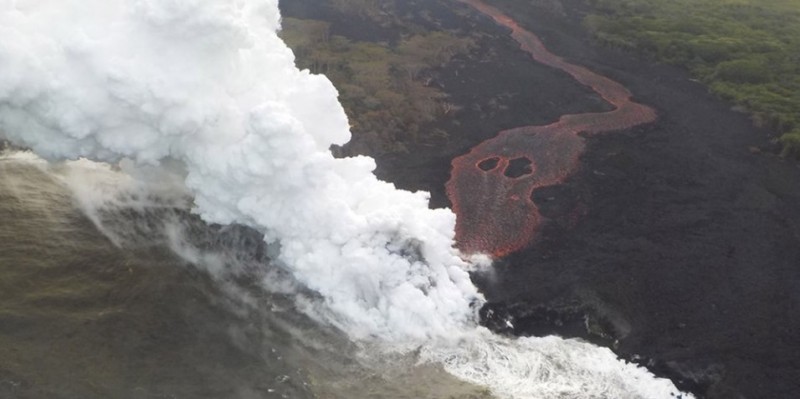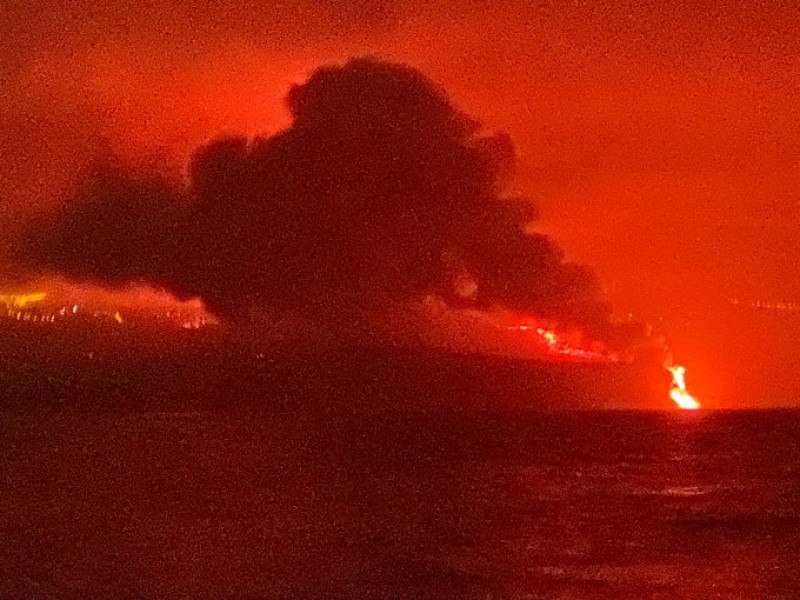Date Published: 29/09/2021
ARCHIVED - La Palma volcano lava finally reaches the sea
The lava has created a golden pyramid-shaped structure off the coast of the Canary Island

The lava flow from the Cumbre Vieja volcano on the Canary Island of La Palma finally reached the sea shortly after 11pm on Tuesday night, September 28, after volcanologists spent a few uncertain days wondering whether it could maintain enough speed and power to make it to the coast. The molten material tumbled off a 100-metre high cliff in the vicinity of Playa Los Guirres to the north of the island, according to the Ministry of Transport, sending plumes of smoke up into the air.

The Canary Islands Emergency Coordination Centre has advised anyone in the vicinity to stay indoors with the windows closed as the clouds of water vapour resulting from a chemical reaction between the lava and sea water could produce noxious gases that are harmful to health. An exclusion zone of two nautical miles has been established and residents have been warned to stay at least 3.5 kilometres away from the area.
Marine geoscientists from the Spanish Institute of Oceanography, who have been following the progression of the eruption closely, have reported that an “impressive” pyramid-shaped structure more than 50 metres high appeared off the coast in less than 45 minutes, and that as the lava flows, the new formation continues to grow.
Observamos en directo el avance de las lavas hasta el pie del acantilado costero que proceden de la colada sur del volcán de La Palma.
— Geociencias Marinas (IEO) (@gemar_ieo) September 28, 2021
Se está generando un impresionante depósito de más de 50 m de altura.#VulcanaIII_0921 @IEOoceanografia pic.twitter.com/jpRn9JIQ4G
In recent hours, the island of La Palma has registered a total of 29 earthquakes in different points, from Villa de Mazo to Fuencaliente or El Paso, registering between 2 and 3.3 points of magnitude on the Richter scale.
The volcano first erupted on Sunday September 19 and it has made its slow progress towards the sea over the past ten days, destroying a total of 656 homes, burying roads and decimating crops in its wake. The destruction is very real and very raw for people living on the island, although some volcano deniers have taken to Twitter, calling it fake news or saying the tragedy was artificially provoked.
The lava eventually reached its destination last night after passing its final stumbling block, the Todoque mountains, and oceanographer Eugenio Fraile described the result as a perfect golden pyramid surrounded by white clouds.
Caída de colada de lava del volcán de #LaPalma desde el acantilado al oeste de Todoque. Formación de cono de depósitos volcánicos y nubes de vapor de agua y desgasificación en campaña de @IEOoceanografia @gemar_ieo @sgeologica @IGME1849 @IGeociencias @VulcanaIEO pic.twitter.com/zV3nDhcAys
— Juan-Tomás Vázquez (@JuanTVaz) September 28, 2021
The white clouds, or plumes of smoke, are caused by the 1,000 degree lava meeting the sea water, whose temperature is currently only at around 20 degrees. According to Involcan, while the columns of vapour are loaded with hydrochloric acid and tiny particles of volcanic glass, they are only a danger to people who are very close to the site, and the current wind patterns are likely to disperse any harmful material very quickly.
Images: Salvamento Maritimo
Contact Spanish News Today: Editorial 966 260 896 /
Office 968 018 268



























